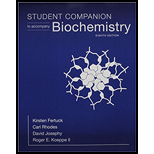
Concept explainers
(a)
Interpretation:
The most suitable matching pair should be selected.
Concept introduction:
Photosynthesis is the process by whichenergy of the sunlight is stored as chemical energy. The process takes place in the chloroplast of the plant cells in two main stages - light reaction and dark reaction.
Answer to Problem 3P
a) Light reactions − generates ATP, NADPH and O2
Explanation of Solution
Photosynthesis consists of two main stages - light reaction and dark reaction.
In light reaction, two photo systems (PS I and PS II) participate.
PSII absorb680 nmwavelengthof sunlight. After absorbing energy from the sunlight, chlorophyll a molecule in PSII release excited high energy electrons. The electron defect occurred in PSII is fulfilled by hydrolysis of water which produce O2as by product. Consider this as reaction 1.
Theelectronsfrom reaction I are used to fulfill the electron defect inphotosystem. The high energy electrons go through the series of electron acceptorsto assimilate this energy. ADP takes up the energy of these electrons to form ATP. This is known as photophosphorylation.
Similar reaction occurs in PS I. PSI absorb 700 nm wavelength of sunlight, followed by high energy electrons release. Like PSII, the high energy electron goes through a series of electron acceptors. At the end of this series NADP+accepts the electron to form NADPH. Consider this as reaction 2.
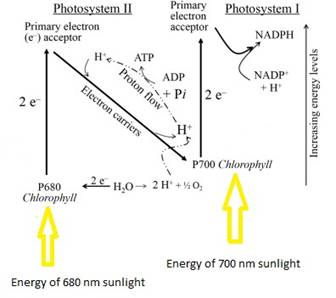
Figure 1: A diagrammatic representation of light reaction
(b)
Interpretation:
The most suitable matching pair should be selected.
Concept introduction:
Photosynthesis is the process by which energy of the sunlight is stored as chemical energy. The process takes place in the chloroplast of the plant cells in two main stages - light reaction and dark reaction.
Answer to Problem 3P
b) Chloroplasts − cellular location of photosynthesis
Explanation of Solution
Chloroplast is the organelle in a plant cell which is responsible for conducting photosynthesis. Chloroplast consists of a double membrane structure known as thylakoid. Thylakoids are the primary site for light reaction which assimilate the light energy to produce the energy moieties, ATP and NADPH. These energy molecules are used in the dark reaction to produce six carbon sugar molecule and oxygen as byproduct. The dark reaction takes place in the stroma of chloroplast.
(c)
Interpretation:
The most suitable matching pair should be selected.
Concept introduction:
Photosynthesis is the process by which energy of the sunlight is stored as chemical energy. The process takes place in the chloroplast of the plant cells in two main stages - light reaction and dark reaction.
Answer to Problem 3P
c) Reaction Center − site of photoinduced charge separation.
Explanation of Solution
In light reaction, two photosystems called PS I and PS II participate.
In these photosystems, the reaction center is a special chlorophyll a molecule, chlorophyll a. The process happening in these two systems is quite similar.
PSII absorbs light energy of 680 nm wavelength of light while PS I absorb energy of 700 nm wavelength of light, followed by releasing high energy electrons.
When the chlorophyll a molecule releases its electrons, the chlorophyll molecule gets positively charged. It generates the charge separation at the chlorophyll molecules. This charge separation is due to the absorbed light energy. So, it is known as photo induced charge separation.
A photosynthetic reaction center is a complex structural view. It is composed of several proteins, pigments and other co-factors. It is a collection of CF1− CF0 complex. This is responsible for executing the primary energy conversion reactions related to photosynthesis. Molecular excitations occur at the reaction center give rise to electron transfer reactions along the path of a series of protein-bound co-factors like chlorophylls.
(d)
Interpretation:
The most suitable matching pair should be selected.
Concept introduction:
Photosynthesis is the process by which energy of the sunlight is stored as chemical energy. The process takes place in the chloroplast of the plant cells in two main stages - light reaction and dark reaction.
Answer to Problem 3P
d) Light-harvesting complex- Primary photosynthetic pigment
Explanation of Solution
Photosynthesis is the process by which energy of the sunlight is stored as chemical energy. The process takes place in the chloroplast of the plant cells in two main stages - light reaction and dark reaction. In the light reaction, the sunlight is assimilated, and the energy is stored in the
The photosynthetic pigments such as chlorophyll a and b, xanthophyll and carotenoids form the two photosystems (Photosystem I and II) which absorbs different wavelength of light. Chlorophyll a form the reaction center of the photosystems.
(e)
Interpretation:
The most suitable, matching pair of answers should be selected.
Concept introduction:
A light-harvesting complex is a collection of subunit proteins. These subunit proteins are again a part of largersupercomplex of a photosystem.
Answer to Problem 3P
e) Light − harvesting complex − uses resonance energy transfer to reach the reaction center
Explanation of Solution
A light-harvestingcomplex (also known as photosystem)is a collection of proteins.The light harvest system is used by plants and photosynthetic bacteria to collect energy from sun light. During photosynthesis, the reaction centers absorbs light energy of 680nm and 700 nm sun light. This reaction center is a special chlorophyll a molecule. Light harvesting complex assist on this energy absorbance.
Light-harvesting complexes show a huge variation among the different photosynthetic organisms. The complexes consist of proteins and photosynthetic pigments like chlorophylls and surround by the photosynthetic reaction center. This special structural adaptation is to focus energy, absorbed from the photons toward the reaction center as resonance transfer.
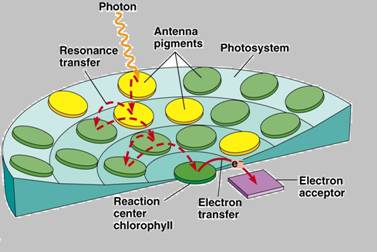
Figure 3: close view of a light harvesting complex
(f)
Interpretation:
The most suitable matching pair of answers should be selected.
Concept introduction:
Photosynthesis is the process by which energy of the sunlight is stored as chemical energy. The process takes place in the chloroplast of the plant cells in two main stages - light reaction and dark reaction.
For the light reaction two photosystems called PS I and PS II participate.
Answer to Problem 3P
f) Photosystem I − powers the formation of NADPH
Explanation of Solution
Photosystem is a collection of pigment moleculesand is known as light harvest complex. In photosystem I, PS I absorb energy from 700 nm photons of sunlight, followed by releasing high energy electrons. The electron goes through a series of electron acceptors. At the end of this series NADP reacts with electron to form NADPH.
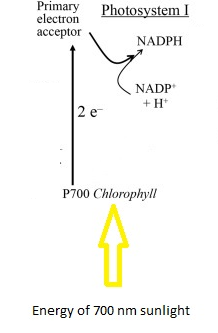
Figure 4: Figure 5: Diagrammatic representation of reactions happen in photosystem one
(g)
Interpretation:
The most suitable, matching pair of answers should be selected.
Concept introduction:
Photosynthesis is the process by which energy of the sunlight is stored as chemical energy. The process takes place in the chloroplast of the plant cells in two main stages - light reaction and dark reaction.
For the light reaction two photosystems called PS I and PS II participate.
Answer to Problem 3P
g) Photosystem II − Transfer electron from H2O to P680.
Explanation of Solution
For the light reaction two photosystems called PS I and PS II participate. PSII absorbs light energy of 680 nm wavelength of sun light After absorbing energy the chlorophyll a molecule in PSII releases excited, high energy electrons. To fulfill the electron defect occurred at PSII water hydrolysistakes place at PSII.
These released electrons are used to overcome the electron defect in photosystemII.
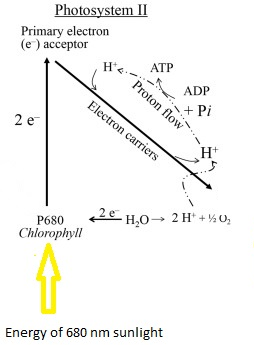
Figure : Diagrammatic representation of reactions happen in photosystem one
(h)
Interpretation:
The most suitable, matching pair of answers should be selected.
Concept introduction:
The chloroplast cytochrome bf complex is a collection of multiple numbers of subunit proteins.
Answer to Problem 3P
h) Cytochrome bf complex − pumps protons
Explanation of Solution
The chloroplast cytochrome bf complex is a collection of multiple numbers of subunit proteins. These subunit proteinsconsist of four polypeptides. These four types are
- Cytochrome f
- Heme containing cytochrome b 6
- Rieske iron-sulfur protein
- 17 kD polypeptide
Most mechanisms suggest that the transfer of a single reducing equivalent which is an electron results in the translocation of two protons across the membrane. So, this complex mainly workes as a proton pump.
(i)
Interpretation:
The most suitable, matching pair of answers should be selected.
Concept introduction:
Photosynthesis is the process by storing energy of sunlight as chemical energy in glucose. Process happens in the chloroplast of a plant cell. Photosynthesis happens via two main stages as light reaction and dark reaction.
Answer to Problem 3P
i) Water -oxidizing complex- site of oxygen generation.
Explanation of Solution
For the light reaction, two photosystems called PS I and PS II participate. PSII absorbs light energy of 680 nm wavelength of sun light After absorbing energy the chlorophyll a molecule in PSII releases excited, high energy electrons. To fulfill the electron defect occurred at PSII water hydrolysis takes place at PSII.
The hydrolysis of water is taken care of by water oxidizing complex. Thereleased electrons are used to overcome the electron defect in photosystem II.
(j)
Interpretation:
The most suitable matching pair should be selected.
Concept introduction:
A photosynthetic reaction center is a complex structural. It is composed of several proteins, pigments and other co-factors. It is a collection of CF1− CF0complex.
Answer to Problem 3P
j) ATP synthase − CF1- CF0 complex
Explanation of Solution
A photosynthetic reaction center is a complex structural. It is composed of several proteins, pigments and other co-factors.It is a collection of CF1− CF0 complex. This is responsible for executing the primary energy conversion. The energy is stored in the form of ATP via this complex.
Want to see more full solutions like this?
Chapter 19 Solutions
Student Companion for Biochemistry
- "Energy Transformation" ATP-ADP CYCLE Construct a final draft sketch on the photoexcitation of Chlorophyll.With labels and explanation.arrow_forwardHelp is appreciated. Think of an unusual eukaryotic species in which its ATP synthase has 12 subunits for its c ring. How many ATP molecules can be produced per pair of electrons that traverse the respiratory chian starting at Complex I? A. 2 ATP/2e- B. 1 ATP/2e- C. 0.5 ATP/2e- D. 1.5 ATP/2e- E. 3 ATP/2e-arrow_forwardThe compound Carbonyl cyanide-p-trifluoromethoxyphenyl hydrazone (FCCP) acts as an uncoupler of electrochemical gradients (in both mitochondria and chloroplasts) by shuttling protons across membranes. Predict the effect of a high dose of FCCP on the synthesis of ATP and NADPH in photosynthesis. Rationalize your answersAnswer separately with prediction and reason please thank you so mucharrow_forward
- Please help me answer questions 71 & 77 71. Which of the following are examples of kinetic energy? A. protons moving through ATP synthase, ATP. B. electrons in chemical bonds proton gradient, ATP. C. electrons moving through the electron transport chain. protons moving through ATP synthase. D. All answer choices are correct. E. electrons moving through the electron transport chain, proton gradient. ----------- 77. The product of photosystem I is A. ANDPH B. Water C. ATP. D. glucose E. NADHHarrow_forwardTrue or False? Electrons after complex III are then sent immediately to complex IV. (during ETC in cellular respiration)arrow_forwardBriefly outline the electron flow in oxidative phosphorylation to describe how its function is directly coupled to ATP synthesis. Be sure to include where the electrons that feed into oxidative phosphorylation come from in your answer.arrow_forward
- Question:- List the different molecules, an electrons is part of, as it moves from NADPH through the light-independent phase of photosynthesis and is synthesized into a substrate that can feed it into a NADH molecule as part of aerobic cellular respiration. Provide 2 different options for NADH production.arrow_forwardTrue or False? In photosynthesis, both photosystems (I and II) depend on the energy of sunlight to excite a chlorophyll molecule until it releases an electron.arrow_forwardFill in the table below. In the first 2 columns, specify what you are comparing and contrasting in Oxidative Phosphorylation and Photosynthesis. In the second 2 columns describe in a 1-3 sentences, how they are the same and how they are different.arrow_forward
- Please answer fast Many commercial herbicides act by inhibiting photosynthetic electron transport. They are investigating three herbicides for potential inhibitors of photosynthetic electron transport. a) How can you determine whether these substances have an inhibitory effect on photosynthetic electron transport? How can you quantify the effect? b) An inhibitor has produced a strong effect in "in vitro" tests, but the effect is significantly less in "in vivo" tests. What can be the reason for the reduced effect "in vivo"?arrow_forwardMAKE A GRAPH FOR ME ON GRAPH PAPER CALL IT ENZYMES VS RATE OF REACTION USING TABLE BELOW GRAPH paper INSERTED BELOW rules: data points must be an x or circled dot, must be on grid paper , the independant variable on the x axis and dependant variable on the y axis, must include titles Regarding the data points: - H2O2 + MnO2 Control #1: (Control #1, 5)- H2O2 + sand control #2: (Control #2, 0)- Plant versus Animal Liver Catalase: (Liver, 4)- Potato: Plant vs. Animal Catalase: (Potato, 3)- Substance Enzyme Concentration (Used Liver): (Liver Used, 4)- Substance Enzyme Concentration (Used H2O2): (Used H2O2, 1) - Boiling Water Bath Temperature: (Boiling Water Bath, 5)- Ice Water Bath Temperature: (Ice Water Bath, 2)- HCl, or pH 3: (H 3, 4)- NaOH at pH 12: (pH 12, 2)- pH 7 (H2O): (assuming average of pH readings; pH 7, not specified) The following explains how to display the graph: Title: Factors versus Enzyme Activity Rate - Labels on X- and Y-axes: Factors and Rate of Enzyme…arrow_forwardRelating to bioenergetics: a. The equilibrium constant for a particular reaction is 6.8 x 10-5 which makes this reaction exergonic. True or False?b. All processes that occur in the universe are spontaneous and have low enough activation energies that molecules can often overcome the energy barrier. True or False?c. ATP has a highly negative free energy change in part because the negative charges on the oxygens repel each other in ATP but less so in ADP. True or False?arrow_forward
 BiochemistryBiochemistryISBN:9781305577206Author:Reginald H. Garrett, Charles M. GrishamPublisher:Cengage Learning
BiochemistryBiochemistryISBN:9781305577206Author:Reginald H. Garrett, Charles M. GrishamPublisher:Cengage Learning
